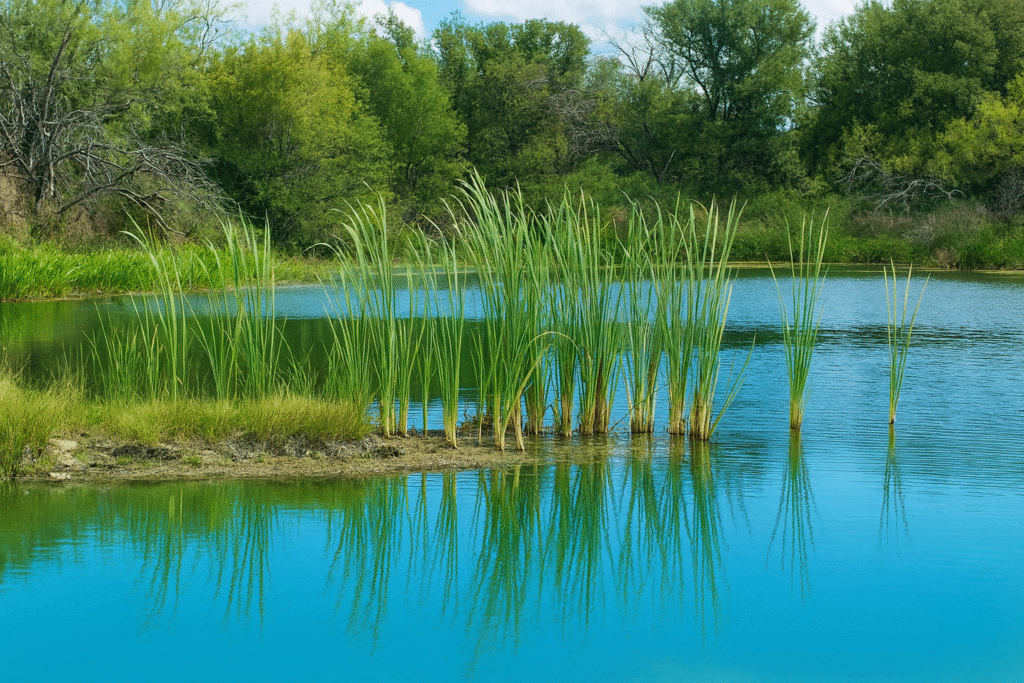When you think of pondside plants, cattails are often one of the first to come to mind. With their tall green stalks and iconic brown flower spikes, cattails (genus Typha) are a familiar sight in wetlands, ponds, and ditches across North America. But beyond their striking appearance, cattails serve a much greater purpose—one that’s vital to the health of aquatic ecosystems: natural water filtration.
Nature’s Water Purifier
Cattails are more than just pretty plants. They’re biological workhorses that clean and restore water quality in ponds and wetlands. Here’s how they do it:
Nutrient Absorption: Cattails absorb excess nutrients, like nitrogen and phosphorus, from the water. These nutrients often come from runoff containing fertilizers or animal waste and can otherwise lead to algae blooms and poor water quality.
Sediment Stabilization: The dense root systems of cattails trap sediments and prevent them from clouding the water. This stabilizes the pond bottom and reduces erosion, keeping the water clearer.
Heavy Metal and Toxin Removal: Research has shown that cattails can absorb certain heavy metals and pollutants, helping to detoxify contaminated water. Their roots act like natural filters, drawing in and breaking down harmful substances.
Oxygenation and Habitat: As cattails grow, they release oxygen into the water, helping aquatic life thrive. They also provide excellent habitat and shelter for frogs, fish, birds, and beneficial insects.
The Beneficial Bacteria Beneath the Surface
Cattail roots (called rhizomes) are more than just anchors in the mud—they’re hotspots for beneficial microbial activity. The area around these roots, known as the rhizosphere, is home to colonies of helpful bacteria that:
Break down organic waste like dead plants and fish waste
Convert nutrients (like ammonia and nitrate) into less harmful forms through nitrification
Prevent algae blooms by limiting excess nitrogen and phosphorus in the water
The cattails even help oxygenate the soil around their roots, supporting aerobic bacteria that work alongside anaerobic ones. Together, these microbes turn your pond’s shallow edge into a natural water-treatment system.
Why You Should Let Cattails Thrive
For pond owners, allowing cattails to establish along the shoreline can lead to clearer, healthier water over time. While it’s important to manage their spread to keep them from overtaking the entire pond, a stand of cattails in key locations can:
Reduce algae growth
Minimize shoreline erosion
Support biodiversity
Improve water clarity
Cattail Management Tips
Strategic Planting: If your pond doesn’t have cattails naturally, you can introduce them by planting rhizomes along shallow shorelines.
Containment: Use barriers or selective trimming to prevent cattails from taking over more space than desired.
Leave Room for Balance: Mix cattails with other native pond plants like pickerelweed, rushes, or water lilies to maintain a diverse, healthy aquatic ecosystem.
Conclusion
Cattails are more than just a nostalgic part of pond scenery—they’re vital components of natural water purification. By harnessing the power of these resilient wetland plants, you can keep your pond cleaner, healthier, and more balanced with minimal human intervention. Nature always knows best.

